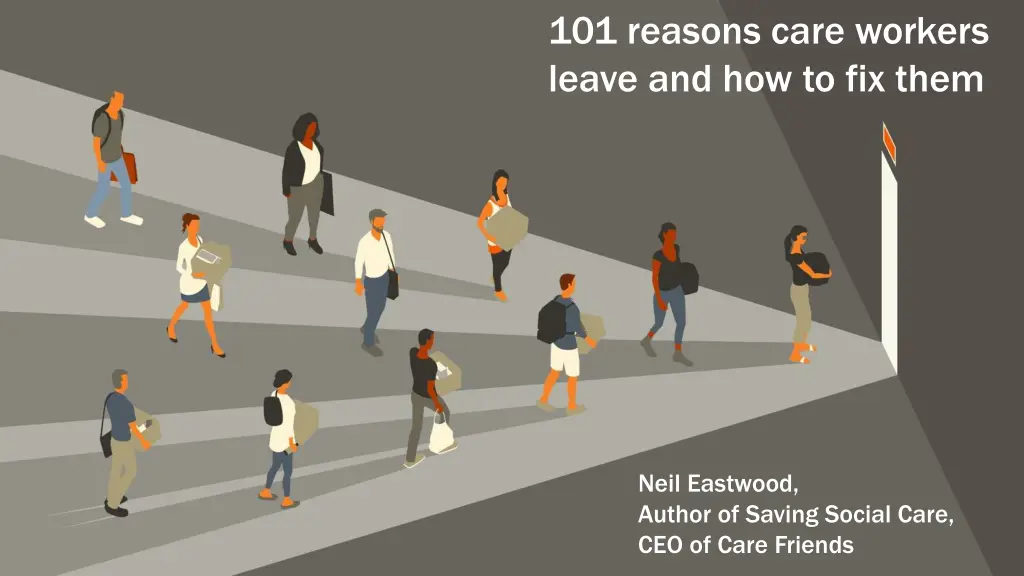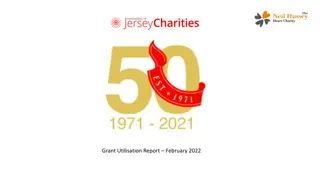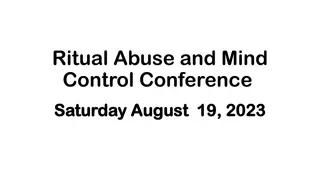
Insights on Care Worker Turnover and Solutions to Retain Talent
Discover the multitude of reasons why care workers leave their roles and learn how to address these challenges effectively. Explore topics such as rural recruitment, financial pressures, and negative perceptions affecting the social care sector. Gain valuable insights from author Neil Eastwood on reducing turnover and improving retention strategies in the care industry.
Download Presentation

Please find below an Image/Link to download the presentation.
The content on the website is provided AS IS for your information and personal use only. It may not be sold, licensed, or shared on other websites without obtaining consent from the author. If you encounter any issues during the download, it is possible that the publisher has removed the file from their server.
You are allowed to download the files provided on this website for personal or commercial use, subject to the condition that they are used lawfully. All files are the property of their respective owners.
The content on the website is provided AS IS for your information and personal use only. It may not be sold, licensed, or shared on other websites without obtaining consent from the author.
E N D
Presentation Transcript
101 reasons care workers leave and how to fix them Neil Eastwood, Author of Saving Social Care, CEO of Care Friends
How did I get here? 1970 s: Vicarage upbringing 2009: How can we fix our 97% homecare annual staff turnover? 2017: Saving Social Care published 2020: Care Friends launched 2nd Edition Saving Social Care 2023:
Rural recruitment and retention >>Prior or current rural residence is the strongest predictor of choice of or staying in a rural care role Most significant impediment to staying, being: >>a partner who was not committed to rural life
As base pay rises so the wage premium for experienced and qualified staff gets squeezed 5+ years care experience = 6p/hour
Small applicant pools - challenges of attracting quality candidates What is causing Somerset care workers to leave? Infrastructure gaps housing, telecoms The rapid decline in sponsored workers Long-term under- funding, with rising demand for services Negative perceptions of both paid care and rural work life Demographic profile ageing workforce and population
Figuring out why staff leave is a puzzle. But there is a way.
There are 101 potential reasons for voluntary turnover 88. problems with client or client's family behaviour 89. supervisor relationship quality - level of respect and decision participation level 90. poor culture and leadership 91. emotional connection with the work/employer 92. poor or limited communication/feedback 93. perceived trust and fairness by management 94. client relationship quality - time for companionship vs tasks 95. levels of manager stress 96. manager turnover 97. socially distressing situations 98. No group problem solving 99. Low worker choice in the workplace 100.visibility and approachability of manage 101.historical turnover rate 1. Age (e.g. retiring, car insurance costs due to age, age-related factors) Education - want to study Race - (e.g. poor treatment due to race from colleagues or clients) Marital status (spousal or family pressure) Gender Personality and personal goals not matching with the role Poor workplace attitude/behaviour Lack of motivation for the role Dissatisfaction with pay and benefits 10. Previous experience in the sector or role 11. Low intrinsic satisfaction with the role/boredom 12. Skills and experience too high or low 13. Family obligations/childcare challenges 14. Transport issues - cost/reliability/access 15. Health, illness or family illness/bereavement 16. Second job/conflict with another job 17. Conflict with benefits payments 18. Career needs 19. Work/life balance 20. Employment and life history 21. Distance from work/travel time/travel cost 22. Household income - financial vulnerability 23. Perceptions of their own employability 24. Lack of pride in the role 25. Poor interpersonal skills 26. Beliefs and values not aligning with the work 27. Confidence they can get another role easily 28. Mental health challenges 29. Number of sickness days 30. Social care qualification - have or not have 31. International sponsored worker or not 32. Emotional maturity/lack of 33. Promises not kept (e.g. pay, hours) 34. Time to hire too long 35. Relationship with recruiter poor 36. Interview experience 37. Hours and contract type not suitable 38. Unrealistic expectations - information about the nature of the job 39. Selection effectiveness 40. Frequency and timeliness of communication poor 41. Training adequacy 42. Level of personal responsibility 43. Isolation/loneliness 44. Quality of orientation and information 45. Communication - knowing what is going on 46. No sense of belonging - welcome from colleague 47. Levels of support from peers, admin staff, management 48. Duration in the job 49. Task variety 50. equipment problems 51. Shift patterns 52. Poor rostering - scheduling, late or changing roster 53. Unsafe neighbourhoods or buildings 54. Appreciation or lack of 55. Recognition or lack of 56. job security/zero hour contracts 57. lack of opportunity for advancement 58. size of facility and organisation 59. span of control and responsibility 60. workload/contracted hours and staffing levels - too few or too many hours 61. autonomy and flexibility 62. perceived ability to do a good job 63. pay and benefits 64. pension enhanced or basic 65. sick pay enhanced or basic 66. work injuries 67. physical setting/environment 68. availability of technology which impacts the job role 69. company ownership status - not for profit vs for profit 70. lack of organisational support (e.g. mental health) 71. Ongoing availability and quality of training 72. Perceived workplace risk 73. physical stress/demands 74. Emotional stress - Trauma - grief processing 75. Perceived attractiveness of substitute employment options 76. Location - accessibility 78. Media image and public perception/distastefulness of the role 79. Local labour market conditions 80. Economy 81. Commissioning practices 82. Immigration policy 83. societal changes - expectations, employer loyalty 84. supervisor/manager supportiveness/personal relationships/empathy 85. Client bond broken (e.g. RIP) 86. strength of relationship/conflict levels with colleagues 87. lack of support from care worker's family and friends/no support structure 2. 3. 4. 5. 6. 7. 8. 9. 77. Unsocial hours/nature of the work
Employee conveyor belt: Generates different reasons to leave at different times Backstory Recruitment Onboarding Employment 01 05 06 02 04 03 Intent to leave can be high even if turnover is low (as we saw during Covid)
Just six categories cover pretty much all 101 reasons FIRST IMPRESSIONS FIRST IMPRESSIONS THE WORK EXPERIENCE THE WORK EXPERIENCE DEMOGRAPHIC / INDIVIDUAL DEMOGRAPHIC / INDIVIDUAL To do with the recruitment process To do with organisational and operational experience and role To do with the individual To do with the onboarding process To do with external factors To do with relationships, culture and engagement 1. Age (e.g. retiring, car insurance costs due to age, age-related factors) Education - want to study Race - (e.g. poor treatment due to race from colleagues or clients) Marital status (spousal or family pressure) Gender Personality and personal goals not matching with the role Poor workplace attitude/behaviour Lack of motivation for the role Dissatisfaction with pay and benefits Previous experience in the sector or role Low intrinsic satisfaction with the role/boredom Skills and experience too high or low Family obligations/childcare challenges Transport issues - cost/reliability/access Health, illness or family illness/bereavement Second job/conflict with another job Conflict with benefits payments Career needs Work/life balance Employment and life history Distance from work/travel time/travel cost Household income - financial vulnerability Perceptions of their own employability Lack of pride in the role Poor interpersonal skills Beliefs and values not aligning with the work Confidence they can get another role easily Mental health challenges Number of sickness days Social care qualification have or not 77. Unsocial hours/nature of the work Media image and public perception/distastefulness of the role Local labour market conditions Economy Commissioning practices Immigration policy societal changes - expectations, employer loyalty 84. supervisor/manager supportiveness/personal relationships/empathy Client bond broken (e.g. RIP) strength of relationship/conflict levels with colleagues lack of support from care worker's family and friends/no support structure 2. 3. 48. 49. 50. 51. 52. Duration in the job Task variety equipment problems Shift patterns Poor rostering - scheduling, late or changing roster Unsafe neighbourhoods or buildings Appreciation or lack of Recognition or lack of job security/zero hour contracts lack of opportunity for advancement size of facility and organisation span of control and responsibility workload/contracted hours and staffing levels - too few or too many hours autonomy and flexibility perceived ability to do a good job pay and benefits pension enhanced or basic sick pay enhanced or basic work injuries physical setting/environment availability of technology which impacts the job role company ownership status - not for profit vs for profit lack of organisational support (e.g. mental health) Ongoing availability and quality of training Perceived workplace risk physical stress/demands Emotional stress - Trauma - grief processing Perceived attractiveness of substitute employment options Location - accessibility 33. Promises not kept (e.g. pay, hours) Time to hire too long Relationship with recruiter poor Interview experience Hours and contract type not suitable Unrealistic expectations - information about the nature of the job Selection effectiveness Frequency and timeliness of communication poor 41. 42. Training adequacy Level of personal responsibility Isolation/loneliness Quality of orientation and information Communication - knowing what is going on No sense of belonging - welcome from colleague Levels of support from peers, admin staff, management 78. 34. 35. 85. 86. 4. 43. 44. 79. 5. 6. 36. 37. 87. 53. 54. 55. 56. 57. 58. 59. 60. 80. 81. 82. 83. 45. 7. 8. 9. 10. 38. 46. problems with client or client's family behaviour supervisor relationship quality - level of respect and decision participation level poor culture and leadership emotional connection with the work/employer poor or limited communication/feedback perceived trust and fairness by management client relationship quality - time for companionship vs tasks levels of manager stress manager turnover socially distressing situations No group problem solving Low worker choice in the workplace 100. visibility and approachability of manage 101. historical turnover rate 88. 47. 89. 39. 40. 11. 90. 12. 13. 14. 61. 62. 63. 64. 65. 66. 67. 68. 91. 92. 15. 93. 16. 17. 18. 19. 20. 21. 94. 69. 95. 70. 96. 97. 22. 71. 72. 73. 74. 23. 24. 25. 26. 98. 99. 75. 27. 76. 28. 29. 30.
My personal experience: Branch turnover ranged from 20% - 178%
Some reasons are more controllable than others Focus on what you can control Alternative employment choices Shift patterns/ flexibility Pay Culture/ Leadership style The Economy Who you Government Policy Very Out of your control controllable hire
There are also many proven retention strategies. Here are seven of my favourites: 01 05 06 02 04 03 To do with relationships, culture and engagement To do with the recruitment process To do with organisational and operational experience and role To do with the individual To do with the onboarding process To do with external factors 2. Develop better ways of screening potential employees and improve the candidate experience 1. Focus your recruiting efforts on supply lines of mature workers with the right values 3. Improve the welcome and invest in training and develop career tracks 4. Develop opportunities for advancement and an organisational support system 6. Develop a culture of compassionate leadership N/A 7. Regular and timely appreciation 5. Use wage differentials, expanded benefits and visible status symbols
Recommendation: Recruit more carefully 01 05 06 02 04 03 To do with relationships, culture and engagement To do with the recruitment process To do with organisational and operational expereince and role To do with the individual To do with the onboarding process To do with external factors 2. Develop better ways of screening potential employees and improve the candidate experience 1. Focus your recruiting efforts on mature workers with the right values 3. Improve the welcome and invest in training and develop career tracks 4. Develop opportunities for advancement and an organisational support system 6. Develop a culture of compassionate leadership N/A 7. Regular and timely appreciation 5. Use wage differentials, expanded benefits and visible status symbols
Example: Values-based recruitment reduces the risk of up to 45 reasons FIRST IMPRESSIONS FIRST IMPRESSIONS THE WORK EXPERIENCE THE WORK EXPERIENCE DEMOGRAPHIC / INDIVIDUAL DEMOGRAPHIC / INDIVIDUAL To do with the recruitment process To do with organisational and operational experience and role To do with the individual To do with the onboarding process To do with external factors To do with relationships, culture and engagement 1. Age (e.g. retiring, car insurance costs due to age, age-related factors) Education - want to study Race - (e.g. poor treatment due to race from colleagues or clients) Marital status (spousal or family pressure) Gender Personality and personal goals not matching with the role Poor workplace attitude/behaviour Lack of motivation for the role Dissatisfaction with pay and benefits Previous experience in the sector or role Low intrinsic satisfaction with the role/boredom Skills and experience too high or low Family obligations/childcare challenges Transport issues - cost/reliability/access Health, illness or family illness/bereavement Second job/conflict with another job Conflict with benefits payments Career needs Work/life balance Employment and life history Distance from work/travel time/travel cost Household income - financial vulnerability Perceptions of their own employability Lack of pride in the role Poor interpersonal skills Beliefs and values not aligning with the work Confidence they can get another role easily Mental health challenges Number of sickness days Social care qualification have or not 77. Unsocial hours/nature of the work Media image and public perception/distastefulness of the role Local labour market conditions Economy Commissioning practices Immigration policy societal changes - expectations, employer loyalty 84. supervisor/manager supportiveness/personal relationships/empathy Client bond broken (e.g. RIP) strength of relationship/conflict levels with colleagues lack of support from care worker's family and friends/no support structure 2. 3. 48. 49. 50. 51. 52. Duration in the job Task variety equipment problems Shift patterns Poor rostering - scheduling, late or changing roster Unsafe neighbourhoods or buildings Appreciation or lack of Recognition or lack of job security/zero hour contracts lack of opportunity for advancement size of facility and organisation span of control and responsibility workload/contracted hours and staffing levels - too few or too many hours autonomy and flexibility perceived ability to do a good job pay and benefits pension enhanced or basic sick pay enhanced or basic work injuries physical setting/environment availability of technology which impacts the job role company ownership status - not for profit vs for profit lack of organisational support (e.g. mental health) Ongoing availability and quality of training Perceived workplace risk physical stress/demands Emotional stress - Trauma - grief processing Perceived attractiveness of substitute employment options Location - accessibility 33. Promises not kept (e.g. pay, hours) Time to hire too long Relationship with recruiter poor Interview experience Hours and contract type not suitable Unrealistic expectations - information about the nature of the job Selection effectiveness Frequency and timeliness of communication poor 41. 42. Training adequacy Level of personal responsibility Isolation/loneliness Quality of orientation and information Communication - knowing what is going on Sense of belonging - welcome from colleague Levels of support from peers, admin staff, management 78. 34. 35. 85. 86. 4. 43. 44. 79. 5. 6. 36. 37. 87. 53. 54. 55. 56. 57. 58. 59. 60. 80. 81. 82. 83. 45. 7. 8. 9. 10. 38. 46. problems with client or client's family behaviour supervisor relationship quality - level of respect and decision participation level poor culture and leadership emotional connection with the work/employer poor or limited communication/feedback perceived trust and fairness by management client relationship quality - time for companionship vs tasks levels of manager stress manager turnover socially distressing situations No group problem solving Low worker choice in the workplace 100. visibility and approachability of manager 101. historical turnover rate 88. 47. 89. 39. 40. 11. 90. 12. 13. 14. 61. 62. 63. 64. 65. 66. 67. 68. 91. 92. 15. 93. 16. 17. 18. 19. 20. 21. 94. 69. 95. 70. 96. 97. 22. 71. 72. 73. 74. 23. 24. 25. 26. 98. 99. 75. 27. 76. 28. 29. 30.
What was your occupation before you became a care worker? Govt target Source: DHSC 2018 N=3000
High performers: What was the trigger for you to become a care worker? Experience of caring for a loved one Persuaded by a friend/ family member works in care I had a calling for care I needed flexible/local work Career change Studied social care or related course Returner to work/retiree Want to be a nurse/social worker First took non-care role in care home Religious reasons Student nurse Volunteered first Brought up in care/traumatic event Brought up by grandparents Source: Neil Eastwood s recruitment masterclasses 2015-2019 N=287
It is not rational to be a care worker considering the alternatives. So, what keeps them?
Religious or spiritual calling 1 to care Emotional satisfaction, pride, self-esteem The hidden psychological pull of care work 2 Surrogate family, 3 personal connection or bond Commitment to, responsibility for the client 4 Haven from personal challenges 5 Influenced by: Mittal, Rosen & Leana 2009
What is hyper-local recruitment? Recruiting within the local community, (<6 km of where the care is delivered) Time can matter more than distance Internet job boards default to 8X this range, so not them! Targeting passive applicants is key 25
Getting hyper-local: Start at your workplace Closely connected to your company Community outreach Partner organisations Community groups Family carers Local job fairs Good leavers Talent pool Client families Word of mouth Inside your company Employee referral Local advertising Flyers/door drops Posters Next Door, Social Media
Why hyper-local recruitment? Candidates can have shared experiences with those receiving care Less commuting Retention likely to be higher Giving back Reaches those not actively job seeking Much much less competition Vetting is easier 27
Your potential candidate pool is much deeper than it appears Active job seekers (Internet job boards, CV search, recruitment fairs ) The personal connections of your workforce Ex-employees and their networks Partner organisations and their supporters Community leaders Cause-related charities and their supporters Unpaid carers Outreach online and offline Life stage changers newcomers, retirees, children growing up
Diversify your recruitment channels Talent pool 5% International 10% Job boards/Aggregator 30% Organic/Free 12% Returners 3% Paid Social 5% Local Advertising 5% Employee referrals 30%
Map your recruitment hinterland https://www.google.com.au/maps/about/mymaps/ 30
Community outreach lots of help waiting! Unpaid carer groups Cause-related organisations Community events Domestic violence refuges Universities Hospices Military bases
Operation Chip Shop Photo by Meelan Bawjee on Unsplash
Look for local changes Newcomers who need work? Businesses closing or relocating? 34 Photo by Josh Olalde on Unsplash
Care Friends An app enabling and rewarding your workforce to be successful recruiters
The performance of the Care Friends app by location classification MMM classifications (1 through 7) MMM 1: metro MMM 2: regional MMM 3-5 rural MMM 6&7 remote
Recruitment processes are often self-harming Active job seeker focus Prefer automated and process-driven approach Email comms CV-centric Domination of job boards Local Central No dedicated recruiter Slow or no response Extended time to hire
Recommendation: Strong welcome and clear opportunities for advancement 01 05 06 02 04 03 To do with relationships, culture and engagement To do with the recruitment process To do with the individual To do with the onboarding process To do with external factors To do with organisational and operational experience and role 1. Focus your recruiting efforts on mature workers with the right values 2. Develop better ways of screening potential employees and improve the candidate experience 6. Develop a culture of compassionate leadership 3. Improve the welcome and invest in training and develop career tracks 4. Develop opportunities for advancement and an organisational support system 7. Regular and timely appreciation 5. Use wage differentials, expanded benefits and visible status symbols
Introduce a Welcome Programme use named welcome signage goody bag fleece, merch personal welcome from the boss peer mentoring book in a future training commitment day 1 wrap-up chat stay interviews Photo by Aaron Burden on Unsplash
More training opportunities = lower turnover Care worker turnover rate by number of training instances between March 2023 and March 2024 Source: Skills for Care State of the adult social care sector 2024 chart 118
Structured opportunities for advancement along two tracks Develop two promotion tracks: Managerial Clinical Registered Manager Nursing Associate Deputy Manager Clinical skills Quality Manager Wound care Care Coordinator Behavioural difficulty specialist Field Care Supervisor Dementia specialist Interpersonal skills Handling stressful situations Dissatisfaction with opportunities for advancement is often second only to dissatisfaction with pay
Recommendation: work on your culture and become a local employer of choice 01 05 06 02 04 03 To do with relationships, culture and engagement To do with the recruitment process To do with the individual To do with the onboarding process To do with external factors To do with organisational and operational expereince and role 1. Focus your recruiting efforts on mature workers with the right values 2. Develop better ways of screening potential employees and improve the candidate experience 6. Develop a culture of compassionate leadership 3. Improve the welcome and invest in training and develop career tracks 4. Develop opportunities for advancement and an organisational support system 7. Regular and timely appreciation 5. Use wage differentials, expanded benefits and visible status symbols
Embed informal appreciation Supervisory staff should be mandated to congratulate care workers publicly for good care - and record it daily. Don t stop there. Send a note or letter if a care worker performs in an outstanding way.
How many care workers said they left their last employer due to a poor workplace culture? 47% 42% Age 21% 10% Source: Skills for Care 2023
The impact of leadership styles From a survey of 2,900 US Nursing Homes Registered Managers who are consensus managers = lowest staff turnover levels 31% of all managers Source: The Gerontologist 2009 Donoghue and Castle Photo by Jason Hafso on Unsplash
Shareholder managers are associated with the highest turnover levels, avg 168% 14% of all managers Source: The Gerontologist 2009 Donoghue and Castle
Offer more choice & flexibility - Shift-swapping and self-rostering Compressed shifts (9-day fortnights) Fixed vs rotating shifts - -






















